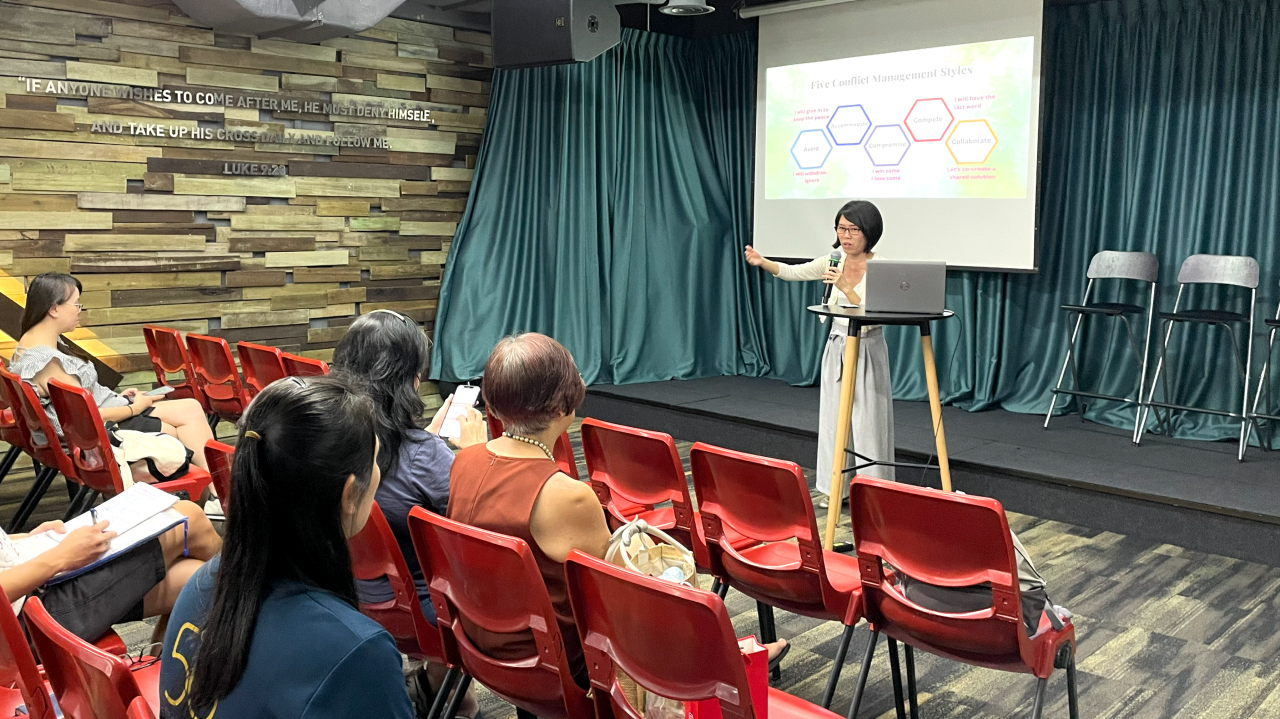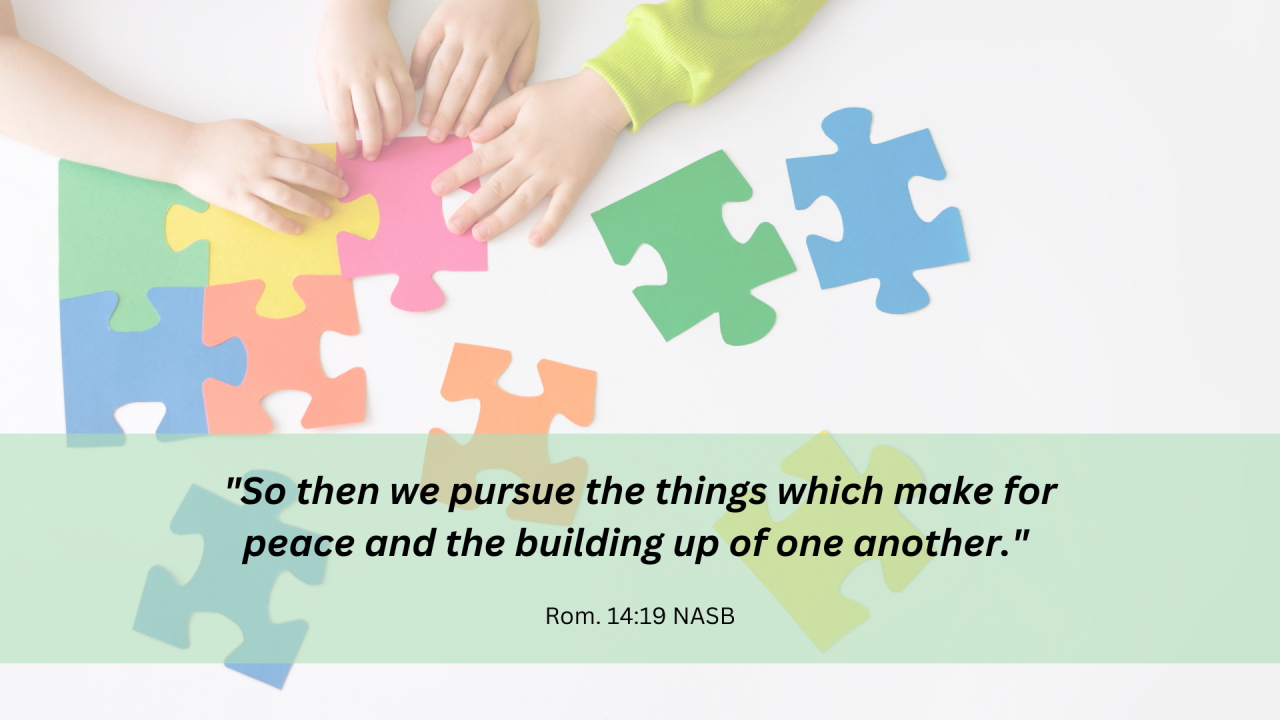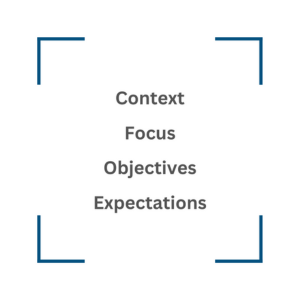"As a little kid, my dad was big and scary," shared Ms. Tsang Weng Yang (Cru Singapore) at #GO Workshop 2: "Conflict Management During Mission Trips".

"It's common for an entire dinner for six to end up on the floor with soup, glass, meat, splattered all over the floor because he was upset. On really bad days, we'd have to run for our lives and stay in temporary accommodation. It was chaotic.
I learnt to tiptoe around my dad and other people. My objective was to make sure the authority figures in my life were happy. This strategy served me well, and I could get along and work with people whom others find difficult.
That changed six years ago when a family situation forced me to face the conflict head-on for the sake of my personal safety.
My experience taught me that:
Conflict management is like any other skill. It can be learnt, and we can get better with experience.
Managing conflict is like learning to swim. The ideal time to learn is not when you’re already drowning.
Conflict isn't inherently good or bad. If we manage it well, with the correct perspective, we grow from it."
Conflict happens when there are people.
Conflicts are a natural part of human interaction. Where there are people, there will be differing views, expectations, goals, and unmet needs. Those differences may lead to tension, disagreement, or confrontation, manifested in behaviours such as avoidance, passive-aggressiveness, or arguments.
Every conflict has the potential for positive or negative consequences. Managed constructively, it leads to growth, improved relationships, and deeper understanding. If left unresolved or mismanaged, the conflict may escalate, causing harm, division, and inefficiency.
Imagine this: you’re going on a mission trip—YAY!
You’re excited to share the gospel and help fulfil the Great Commission with a group of like-minded, passionate believers!
You start making plans and crafting a programme, and then these passionate people start having different ideas about a host of different things.
Kaboom! Suddenly you have conflict brewing.

Actual incidents that happened in some of our recent mission trips. (A creative access country is where there are heavy restrictions on efforts to share the gospel. A cheongster is a person who speeds/rushes and expends a lot of time, energy to do/complete something.)
Short-term mission teams often consist of individuals who are unfamiliar with each other, and have differences in personality, preferences, habits, communication styles and expectations.
Time pressure typically affects mission trip teams. You have a very short time to know each other, establish norms and learn to work and live together. During the trip, you are exposed to high-pressure environments, long working hours, limited resources, and emotional strain—all these can ramp up stress levels.
In addition, mission trips often take place in culturally foreign settings, where both participants and the host must navigate cultural differences and norms.
Conflict Management is the use of processes, tools, and skills to identify and manage disagreements respectfully and creatively. The goal is to minimise the potential negative impact that can arise and increase the odds of a positive outcome.
The Thomas-Kilmann Model of conflict resolution, developed by Dr. Ralph Kilmann and Dr. Kenneth Thomas in 1974, identifies five conflict management styles:
Avoiding (I will withdraw, ignore) is when people ignore or withdraw because the discomfort of confrontation outweighs the potential reward of resolving the conflict. For example, choosing to move to another seat on the bus instead of telling the stranger next to you to tone down the phone volume.
Accommodating (I will give in to keep the peace) is where one party gives in to the wishes or demands of another. People generally adopt this strategy when they are not prepared to, and are unable to advocate for themselves.
Compromising (I win some, I lose some) is where everyone gives up a little bit of what they want in order to move on. All parties win some and lose some.
Competing (I will have the last word) is like going into a match. There will be a clear winner. We generally see these types of engagements in litigation where cases have to be won.

5. Collaborating (Let’s co-create a shared solution) is when people come together to advance their individual needs and perspectives, with the aim of co-creating mutually beneficial solutions.
There are pros and cons with each strategy.
When you avoid conflict, it seems easy but nothing is resolved. Both parties may move on but avoiding doesn't add to mutual growth.
Accommodating appears to be a gracious way to give in but too much accommodation could mean only the interests of the most assertive get met, where the strong do what they can and the weak suffer what they must.
In compromising, the focus is on "settling". This approach can generate straightforward functional solutions. For instance, if your roommate spends an excessive amount of time in the shower, you might ask to shower first so that he/she can take his/her time. Yet, parties in the dispute may continue to harbour dissatisfaction that can resurface if interaction is prolonged.
Competing is a strategy needed in sports or war, but rarely a good strategy for problem solving. The goal is to win, not problem solve. The environment can quickly become combative and aggressive.
Collaborating is great for co-creating solutions that parties can own and move forward with, but it usually takes more time and energy.
Regardless of which strategy you choose, there are trade-offs. If you choose to avoid conflict, be prepared to accept the current situation and handle any emotional discomfort. If you choose to collaborate, you'll need to set aside time and energy, which may be in short supply during a mission trip.
Bottomline: there is no right or wrong, good or bad style. It depends on individual contexts and your goals.
This workshop focuses on an approach that:
a. Prepare Spiritually
Firstly, pray and bring the issue before God. By going to God in prayer, we are reminded of values like love, compassion, humility, patience, and forbearance (1 Cor. 13). This in turn, helps us to regulate our emotions and responses.
Prayer also helps broaden our perspective beyond our immediate reaction and desire for redress to one of pursuing enduring solutions that honour God.

b. Manage Internal Story and Emotions (Stimulus to Action)
Consider a scenario where a team member is consistently late for meetings. [Stimulus]
We observe this behaviour and internally process it through a story, which is essentially our own interpretation of the observed behaviour. [Internal Story]
Some might attribute the lateness to reasons such as poor time management or unreliability while others might consider the possibility that the person has a heavy workload. This process occurs entirely in our mind. It happens unconsciously and very quickly.
What follows after our internal stories is an emotional response. [Emotion]
If you view your teammate as unreliable, how might that affect your feelings? Conversely, if you consider that the person may be struggling with work and caregiving, how would you feel?
Depending on your internal story and consequent emotions, you might decide to ignore the behaviour and not let it bother you. Or you might decide to tell the person off. You could also decide to approach your teammate with curiosity, and find out the reason behind the lateness. [Action]
One way to manage your internal stories is to give yourself breathing space, take time to acknowledge your feelings, and share them with someone you trust before engaging with the conflict.
When internal stories aren’t managed well, we see incidents like road rage, and fights because one person looked another the wrong way. This makes it all the more important for us to be aware of what stories we are telling ourselves.
c. Prepare Mentally
Gain clarity on the situation by asking yourself:
What are the facts and context involved?
How does it impact me, including my emotions?
How have I contributed to the situation?
What outcome am I aiming for?
What outcome am I hoping to prevent?
d. Prepare Location and Time
Pick a time when both parties are likely to be well-rested, as heavy conversations are best avoided when everyone is fatigued after a long day. Choose a setting that offers privacy and is quiet enough that you can hear each other clearly.
During mission trips, it may be challenging to find the ideal time and place, so it could mean focusing on conversations that achieve the minimum level of resolution necessary to move forward.

Photo by Priscilla Du Preez on Unsplash
e. Prepare Your Posture
i. Be Curious
"How can you think like that?!" vs. "How would you describe the situation from your perspective?"
Curiosity prompts you to challenge your assumptions by questioning your biases and preconceived notions. It also communicates that you are interested in understanding their perspectives.
ii. Be Empathetic and Respectful
"I can see why that would be upsetting for you." [Validate and empathise]
"Thank you for sharing your thoughts and how you felt. It has helped me understand where you're coming from." [Value their input]
When we communicate with genuine concern, humility and gentleness, we convey the message that we care for how they feel or why they are upset.
iii. Take Responsibility
"I'm sorry that [……] have caused you distress. I acknowledge there are areas where I could have handled [……] differently. I hope to learn from this experience and work together with you to resolve it."
Once we recognise our role in a conflict, we can begin to figure out what we can do to improve the situation. Remember—the only person we can change is ourselves.
iv. Be Collaborative and Flexible
"What are your thoughts on how we can [……] and resolve this issue? What do you think would be a reasonable outcome for both of us?"
When you collaborate, you're aiming to work through disagreements to arrive at mutually agreeable solutions. This helps to preserve relationships, build trust, and maintain the team's ability to work together.
v. Avoid Black-and-White Thinking
"If I’m right, you must be wrong."
If we reduce situations to simplistic terms of right or wrong, we fail to consider differences in personality, perspectives, and cultural nuances. Emotions can intensify, leading to defensiveness or hostility. The focus shifts from problem-solving to proving oneself right, which hinders progress.
vi. Be Willing to Commit
Once a decision is reached, commit to it and move forward as a team. This entails making the best of the decision and working together to solve any challenges that may arise.
This technique puts a boundary around the content of the conversation to filter out irrelevant information. It sets out the background, context, and guides the focus of the discussion. Framing also helps ensure that objectives are clear and realistic, and expectations are manageable regarding the tone and desired outcome of the discussion.

a. Describe the issue from your perspective, and invite theirs.
"I noticed that you’ve been having difficulty showing up to team meetings on time. [Fact]
As a result our meetings ran longer than planned. [Impact]
After a few times, I start wondering if … [Your story]
So I wanted to take a moment to hear from you what's been happening." [Invite their perspective]
Remember, your story is your assumption so share it as a possibility, not a certainty. You might even find your assumptions to be riddled with inaccuracies after hearing the other person's side of the story.
b. Appreciate their input, and validate what you heard.
Express your appreciation, and then paraphrase to validate what you heard. For instance, if the person says she needs more time to buy souvenirs for her aunt whom she misses very much. You might paraphrase, "Thank you for sharing that with me. I can see that your aunt means a lot to you."
Do take the time to validate and empathise with how they felt. People can discern insincerity if you rush through the conversation like ticking boxes on a checklist.
c. Express your intent clearly, and seek common ground.
"I wanted to talk with you because it’s important to me that we work well together." [What you want]
"I don’t want this issue to remain unresolved between us." [What you do not want]
"I believe we can find common ground and build from there to resolve this issue. What would you like to see happen?" [Find a mutual goal]
a. One Issue at a Time
Focus on one issue at a time to maintain clarity and focus in the discussion. Prioritise issues based on importance, impact, and urgency, addressing the most critical ones first.
b. Be Specific
"She consistently interrupts others during team meetings." vs. "There are some issues with her behaviour in meetings."
When you use clear language, you give clarity to the issue at hand. Avoid terms like "always," as they lack specificity. Instead, describe the frequency or occurrence of the behaviour.
c. Stay on Topic
"I'm glad we've explored various angles. Now let's zoom in on the specific issue of ..."
Redirect the conversation back to the main issue if it veers off track.
d. Active Listening
"I'm hearing you say [paraphrase key points]. Did I understand you correctly? [pause for response]. Is there anything else you’d like to add?"
Practise active listening by reflecting back what you've heard to ensure understanding. A good question to ask yourself is: Am I visibly demonstrating that I'm listening?
To reach a resolution, ensure both parties have expressed their point of view. Strive for options that ideally meet the most important needs of both parties. Use information gathered during the conversation to develop a solution. Be specific on your agreed course of action.
Why is it important to manage conflicts well, especially during mission trips?
Because unresolved conflict impacts relationships and communications within the mission team. Not only that, our personal witness and ministry effectiveness may be jeopardised as well.
God is honoured when there is unity. On the contrary, when there is disunity and discord, it gives the enemy an opening to attack us.
In John 17:21 Jesus prayed, "that all of them may be one, Father, just as you are in me and I am in you. May they also be in us so that the world may believe that you have sent me."
When the unbelieving world witnesses how we, as the body of Christ, pursue peace and the building up of one another in love and unity, it may well be just the platform that God uses for them to see and experience God for themselves!
Tsang Weng Yang
Certified Transformational Coach (Advanced Level by Coach Masters Academy)Senior Executive, Leadership Development & Human Resources
Weng Yang loves to see growth and impact in the lives of people. That’s what drew her to join Cru in 1992.
Having worked with students, working professionals, special needs children, and missionaries, she’s experienced in relating with diverse groups of people. She enjoys helping people with diverse viewpoints find common ground so they can move forward better together.

©1972-2025 Cru Singapore. All Rights Reserved.